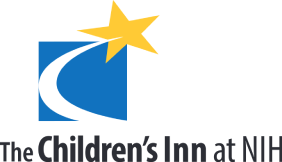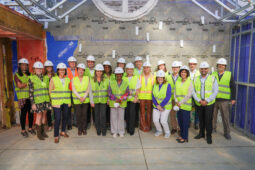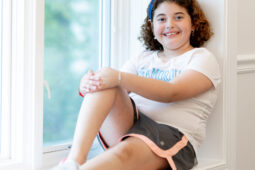‘Fragile Like Kristal’: An All of Us Story
This story is being re-published with permission from the NIH’s All of Us Research Program, which highlights the personal perspectives and experiences of program participants, partners, researchers, and leaders. Kristal Nemeroff and her family were among the first to stay at The Children’s Inn at NIH when it opened in 1990.

The name of Kristal Nemeroff’s hometown in the Pocono Mountains is a poetic reinforcement of her life: Effort, Pennsylvania.
Just getting up every day takes effort for Kristal, 35, who has a genetic condition called osteogenesis imperfecta (OI), commonly known as brittle bone disease. Yet she rises and powers through.
Her perseverance despite significant obstacles has allowed Kristal to push the bounds—physically, personally, and professionally. She credits her family’s unwavering support and her lifelong participation in groundbreaking medical research at the National Institutes of Health with motivating her to break barriers.
Her mother, Carla Nemeroff, also has OI and knew there was a 50-50 chance that her child would inherit the condition. Six months into Carla’s pregnancy, an ultrasound confirmed that her baby’s femur (or thigh bone) was fractured in the womb. When Carla gave birth by cesarean section in January 1988, the newborn’s right femur had healed. Carla knew her baby was going to have fragile bones and decided the perfect name would be Crystal. But when she wrote the first three letters, “C-r-y,” she knew she would have to change the spelling, in celebration of her daughter’s life.
Carla Nemeroff changed more than the spelling of Kristal’s name; she changed the trajectory of her health. Today both mother and daughter are continuing their journey in medical research as All of Us participants because they believe in the power of science and human connectivity.
Even though our DNA is different from others’, we are all connected,” Kristal said. “The more we know, the better we will be collectively.”
Mother and Daughter: Same Rare Disease, Different Outcomes
Carla was born in 1962 in the same hospital where her daughter was born years later, but Carla’s life experiences were more severely limited from an early age. When Carla was born, doctors encouraged her parents to put her in an institution for people with disabilities. Her parents declined, carried their newborn baby home gently, and raised her with high hopes, decades before the Americans with Disabilities Act (ADA) granted people with disabilities equal access to public school, along with other basic civil rights. Local school officials prohibited Carla from attending elementary school until the fourth grade, when she was placed with other students with disabilities. In high school, she was integrated into the general classrooms.
Years later, when she became a mother, Carla promised to give her daughter opportunities she never had. “I was determined to find the best pediatric doctors, the best medical treatments, and real educational opportunities for my daughter,” Carla said. “I knew my rights, and I was her advocate.”
Carla researched to find resources and treatments to help her daughter, which led her to NIH.
Research at the NIH

Kristal at the NIH Clinical Center
Carla learned about the Osteogenesis Imperfecta Foundation, which informed her of a clinical research trial at the Eunice Kennedy Shriver National Institute of Child Health and Human Development (NICHD), part of NIH. Carla enrolled Kristal at eight months old. Her NIH treatments included long leg braces, which were key to helping her stand and walk.
Kristal was one of the first participants in a novel OI natural history study led by NICHD’s Joan Marini, M.D., Ph.D., then chief of NIH’s Bone and Extracellular Matrix Branch. Dr. Marini was assisted by NIH Clinical Center colleagues working in rehabilitation medicine, nuclear medicine, radiology, audiology, and the NIH Dental Clinic.
Brittle bone disease is a rare genetic disorder that affects a protein called collagen, which is found in bone, teeth, skin, tendons, and parts of the eye. People with the condition have bones that can break easily, sometimes with no obvious cause. Kristal’s participation in the NIH study, alongside dozens of OI patients, helped researchers better understand the impact of OI on the body, such as changes in lung and cardiac function, energy metabolism, and dental structure. NICHD- and NIH-supported research has also been instrumental in uncovering many of the genes that cause rare recessive types of OI.
At 13, Kristal was one of 18 children who participated in an NIH clinical study examining the effectiveness of the drug pamidronate, which is used to increase bone density and slow the breakdown of bones. During the study, she and her family stayed across from the NIH Clinical Center at The Children’s Inn at NIH, which offers families with seriously ill children a welcoming “Place Like Home” to stay free of charge while participating in NIH research. Kristal and her parents came four times a year so that Kristal could receive pamidronate intravenously at the Clinical Center. This was the first controlled study of children with OI in the United States to examine the effectiveness of bisphosphonates—a group of drugs used to limit the loss of bone density. The study demonstrated that children experienced significant improvements in bone density and reductions in spine vertebral compressions after one year of treatment, although rates of long bone fractures were unchanged.
In just a few weeks after her first infusion, she started to feel greater mobility and less pain in her spine. “I’ll never forget waking up and noticing that my back didn’t hurt as much, and I could stand up more comfortably,” Kristal said. “It gave me hope.”
Throughout her childhood, Kristal traveled to NIH several times a year and overcame multiple challenges, including 25 broken bones, 10 major surgeries, and months of immobility.
Nurse Nemeroff
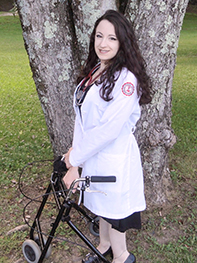
Nurse Kristal after graduating from East Stroudsburg University’s nursing program
Kristal credits her experiences in research studies at NIH with strengthening not only her bones but also her determination to pursue a career in nursing.
“The NIH nurses treated me with such patience, understanding, and kindness,” she said. “They had a huge impact on my life.” Seeing the nurses go the extra mile to care for her “made me realize this is something that I could see myself doing—caring for people, being a nurse.”
But when she applied for nursing school in Pennsylvania, she faced objections from administrators who questioned her ability to succeed as a nurse. Again, she leaned on her health care providers at NIH. Scott M. Paul, M.D., then an associate research physician specializing in physiatry (physical medicine and rehabilitation) at the Rehabilitation Medicine Department in the Clinical Center, wrote to endorse her capabilities to pursue a nursing career.
“Kristal is medically cleared to participate in a college course of study leading to a degree as a registered nurse,” Dr. Paul wrote. “Kristal unequivocally has the intelligence, motivation, and compassion to excel in the nursing field.”
“It was the most important letter of my life,” she told Dr. Paul in a conversation with the online platform StoryCorps. She received her certificate as a registered nurse and completed her bachelor’s degree in nursing science in 2011. That year she achieved her dream when she was hired as a nurse at an elementary school in Pennsylvania, not far from her hometown.
“There’s nothing wrong with her cognition; in fact, Kristal has above-average intelligence,” Dr. Paul said. “But often when many people look at someone in a wheelchair, there is a lot of bias leading to incorrect assumptions.”
“Rules and bones are meant to be broken,” Kristal wrote in a 2018 personal blog post in Scrubs magazine. The message she gives others with disabilities is, “Never say, ‘I can’t.’”
“My strength was managing the kids with chronic conditions,” Kristal said. “It was inspiring for them to see someone in a wheelchair who is capable and smart.” She remembered one young girl with cerebral palsy. The girl would come to Kristal’s office to rest after completing adaptive physical education, which Kristal knew from experience was an intense workout. Some staff questioned the break and were dismissive. “They would say, ‘Oh, she’s milking it.’” Kristal recalled. “I would have to tell them, ‘No, she’s tired, and she’s still a tough kid.’”
Kristal says her life’s goal is to teach children that even if they have a chronic illness or disability, they have the right to health care, education, and the opportunity to pursue their dreams.
“As a nurse with a disability, I feel fulfilled by challenging general perceptions about disabilities,” Kristal said. “Having the patient perspective from my experiences has made me a great nurse.”
She worked until 2017, when she took time off to start her own family.
The Next Generation
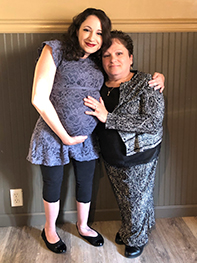
Kristal, pregnant in 2019, with her mom Carla.
Another milestone for Kristal was becoming a mother to sons, Clayton, 3, and Christian, 1. Two pregnancies in four years took a lot of fortitude and effort. She was in her wheelchair full-time. “It really was a chore to do anything,” she said of her last pregnancy. NIH received cord blood samples after the boys were born and tested them for her genetic condition.
Although neither of her boys inherited OI, Kristal said she participates in All of Us in part to advance knowledge and treatment of brittle bone disease. She is one of 60 All of Us participants with OI whose data can be examined by researchers to advance research about the condition.
“I want my sons to have as much information as possible when they grow up and have families,’’ she said.
Strength in Singing
Throughout her life, one of the ways Kristal has maintained her strength and stamina is through singing. She started sharing her voice as a toddler. In church, the organist noticed how much she enjoyed singing and encouraged her. As a teenager, she hosted telethons and performed for a local nonprofit that raised funds for children with chronic conditions. Later she sang the national anthem at a Baltimore Orioles game and at events for The Children’s Inn. The Inn, with a grand piano, gave her space and peace of mind to express her talents.
“At The Children’s Inn, families come from all over the world and speak many different languages,” Kristal said. “But what I found out was that music is a universal language. You don’t need to know what it means to feel the music.”
She shared her passion for singing in the NICHD podcast Milestones, singing her version of Lady Gaga’s song “Born this Way.”
“Kristal is amazingly resilient, very positive, and knows how to find joy,” said Dr. Paul. He remembers that when she was young, she would always sing to him.
Music was a way for Kristal to be an ambassador for the disability community, he added. Kristal was completely comfortable putting herself on stage, front and center, and saying, ‘Forget about my disability; listen to my voice.’ ‘‘
Now Kristal is teaching her older son to play the piano and sing. She is looking forward to returning to work as a school nurse when her children reach school age. The work is physically demanding, but Kristal knows all about putting in the effort—and how it pays off in the end.
